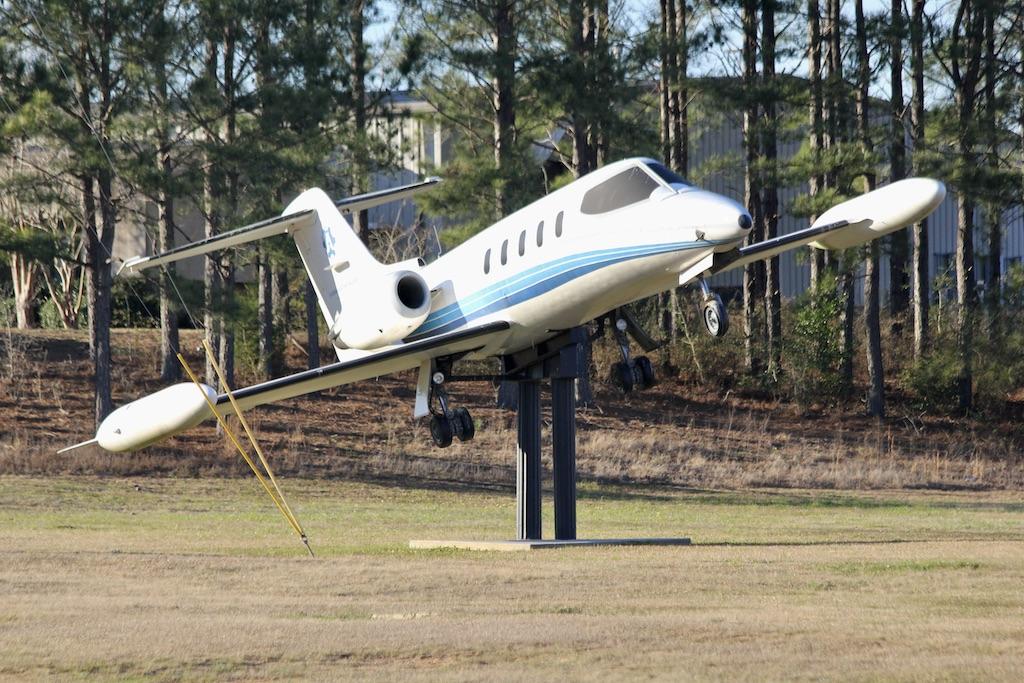
An example of a Learjet 25, a business jet type the FAA certified in 1967.
In August 2013, nine months after the initial investigative launch, Mexican civil aviation regulator DGAC found a pilot who had flown the ill-fated Learjet 25 that carried singer Jenni Rivera and four other passengers.
In a detailed statement, the pilot confirmed that “in flight, when climbing, upon reaching 265 kt., the plane’s control column vibrated, and he could feel it on the fuselage. During straight and level flight, the vibration reappeared at Mach 0.74. If the speed increased, so did the vibration. If the stall warnings were shut down, the vibration continued.”
Based on this pilot’s statement, the accident flight crew would have been experiencing control column and fuselage vibrations before it leveled off at 28,700 ft.
How could these vibrations have preceded a pitch down when the jet’s speed was still below the expected Mach tuck onset speed of about 0.80? An FAA special certification review of early Learjets conducted in 1981 explains.
The certification review said in part: "'Aileron buzz' onset occurs just above Maximum Mach Operating speed; at higher Mach number and/or higher load factors, aileron 'snatch' (rapid, large deflection aileron motion) occurs. Loose (misrigged) aileron cables could increase the amplitude and lower the onset Mach number, since the major factor which damps this motion is control system friction."
The report added: “Extension of the spoilers at high speed causes a large nose down pitching moment. For the Lear 25 D/F Models, stick force required to hold airspeed with spoiler extension at VMO varies from 46 lb. at aft c.g. to 84 lb. at forward c.g.”
The captain of the accident aircraft allegedly liked to “go fast.” The jet was obviously out of rig, and misrigged Learjets are susceptible to early onset of Mach tuck. Using the spoilers increases the pitch down force. If you put these facts together, you get one reasonable explanation for what happened.
The crew of the accident jet allowed the misrigged aircraft to accelerate into an area of vibration and premature Mach tuck. The Learjet began to pitch down, and one or both pilots tried to slow it by reducing power and extending spoilers. They applied back pressure to try to maintain altitude, but the pitch down force was too strong. The jet then descended out of control.
The early Learjet accidents that prompted the special certification review took place so long ago that extensive investigative reports from that era are not always accessible in the NTSB’s online database. The reports included: Sky Train Air, Inc. Gates Learjet 24, N44CJ Felt, Oklahoma, Oct. 1, 1981; Northeast Jet Company, Gates Learjet 25D, N125NE Gulf Of Mexico, May 19, 1980; and IBEX Corporation, Gates Learjet 23, N100TA, Atlantic Ocean near Savannah, Georgia, May 6, 1982.
A bigger issue than the loss of one jet, as tragic and terrible as it was, is the continuing flow of mostly aging “N” numbered jets to Mexico and other countries. Foreign owners use trusts and false addresses to register their aircraft in the U.S., then operate them outside the country, where they rarely get the maintenance and oversight required by law. In addition, they are sometimes used for illegal activities, like smuggling, where the U.S. registration can deter scrutiny by officials in foreign countries.
Rivera and her entourage were naive travelers who accepted a free ride, not knowing the jet was old and not airworthy. The owner portrayed the flight as a sales demonstration to avoid meeting charter rules. If he had sold the Learjet, he would have profited.
FAA Registry Reform
In April 2024, U.S. Sen. Chuck Grassley (R-Iowa) released a report entitled “Criminal Exploitation of the Federal Aviation Administration Registry.” The report cited critical information gaps in the FAA Registry and the use of shell companies and noncitizen trusts to register aircraft. It cited Starwood LLC as an example of a shell company.
The Grassley report also cited a U.S. Government Accountability Office (GAO) report issued in 2020 that addressed fraud and abuse in aircraft registry. Most of the GAO’s recommendations on this subject have not been implemented.
Grassley and Sen. Sheldon Whitehouse (D-R.I.) in April introduced legislation called the “Preventing Terrorist and Narcotic Air Events Act,” to require implementation of the GAO’s recommendations. The bill was referred to the Senate Commerce, Science and Transportation Committee.
A state’s division of motor vehicles has more information on you and your car than the FAA now has on most aircraft. Making the FAA Aircraft Registry more thorough and accurate will not affect the average aircraft owner, but could help prevent accidents like the one that took singer Jenni Rivera’s life.
To read Inexplicable Descent Of A Learjet 25, Part 1, click here.
To read Inexplicable Descent Of A Learjet 25, Part 2, click here.





